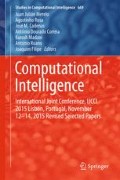Abstract
Modeling and forecasting human mortality are significant research topics in several disciplines because mortality rates are fundamental in planning and policy decisions. Among various techniques, Lee Carter (LC) model is one of the most popular stochastic method in human mortality modeling. The original LC model was fuzzified to eliminate the assumptions related with homoscedasticity. The existing fuzzy model makes use of ordinary least squares (OLS) technique, which prevents the model to capture the existing fluctuations in data. In this study, a revised version of fuzzy LC model utilizing singular value decomposition (SVD) technique is proposed to overcome this issue. After modeling the mortality rates, their future values are forecasted by a modified first order fuzzy time series technique. For illustration purposes, proposed method is applied to mortality data of Finland. Numerical outputs show that proposed method is statistically better in modeling mortality compared to the existing fuzzy method. In addition, the modified fuzzy time series technique generates better forecasts than the original version.
References
Keyfitz, N.: Applied Mathematical Demography. Wiley, New York (1977)
Hyndman, R.J., Ullah, M.S.: Robust forecasting of mortality and fertility rates: a functional data approach. Comput. Stat. Data Anal. 51, 4942–4956 (2007)
United Nations: Manuals on methods of estimating population - Manual VIII: Methods for Projections of Urban and Rural Population, Department of Economic and Social Affairs, Population Studies, No. 55, New York (1974)
Lindh, T.: Demography as a forecasting tool. Futures 35, 37–48 (2003)
Ahmadi, S.S., Li, J.S.: Coherent mortality forecasting with generalized linear models: a modified time-transformation approach. Insur. Math. Econ. 59, 194–221 (2014)
Danesi, I.L., Haberman, S., Millossovich, P.: Forecasting mortality in subpopulations using Lee-Carter type models: a comparison. Insur. Math. Econ. 62, 151–161 (2015)
French, D.: International mortality modelling - an economic perspective. Econ. Lett. 122, 182–186 (2014)
Booth, H.: Demographic forecasting: 1980 to 2005 in review. Int. J. Forecast. 22, 547–581 (2006)
Lee, R.D., Carter, L.R.: Modelling and forecasting US mortality. J. Am. Stat. Assoc. 87, 659–671 (1992)
Lee, R.D., Tuljapurkar, S.: Stochastic population projections for the U.S.: beyond high, medium and low. J. Am. Stat. Assoc. 89(428), 1175–1189 (1994)
Li, S.H., Chan, W.S.: Outlier analysis and mortality forecasting: the United Kingdom and Scandinavian countries. Scand. Actuarial J. 3, 187–211 (2005)
De Jong, P., Tickle, L.: Extending Lee-Carter mortality forecasting. Math. Popul. Stud. 13, 1–18 (2006)
Renshaw, A.E., Haberman, S.: Lee-Carter mortality forecasting with age specific enhancement. Insur. Math. Econ. 33(2), 255–272 (2003)
Brouhns, N., Denuit, M., Vermunt, J.K.: A Poisson log-bilinear approach to the construction of projected life tables. Insur. Math. Econ. 31(3), 373–393 (2002)
Currie, I.D., Durban, M., Eilers, P.H.C.: Smoothing and forecasting mortality rates. Stat. Model. 4(4), 279–298 (2004)
Lazar, D., Denuit, M.: A multivariate time series approach to projected life tables. Appl. Stochast. Models Bus. Ind. 25(6), 806–823 (2009)
Hatzopulos, P., Haberman, S.: A dynamic parameterization modeling for the age–period–cohort mortality. Insur. Math. Econ. 49, 155–174 (2011)
Giacometti, R., Bertocchi, M., Rachev, S.T., Fabozzi, F.J.: A comparison of the Lee-Carter model and AR–ARCH model for forecasting mortality rates. Insur. Math. Econ. 50, 85–93 (2012)
Christiansen, M.C., Niemeyer, A., Teigiszerová, L.: Modeling and forecasting duration-dependent mortality rates. Comput. Stat. Data Anal. 83, 65–81 (2015)
Ahcan, A., Medved, D., Olivieri, A., Pitacco, E.: Forecasting mortality for small populations by mixing mortality data. Insur. Math. Econ. 54, 12–27 (2014)
Lee, R.D.: The Lee-Carter method for forecasting mortality, with various extensions and applications. North Am. Actuarial J. 1(4), 80–91 (2000)
Koissi, M.C., Shapiro, A.F.: Fuzzy formulation of Lee-Carter model for mortality forecasting. Insur. Math. Econ. 39, 287–309 (2006)
Tanaka, H., Uejima, S., Asai, K.: Linear regression analysis with fuzzy model. IEEE Trans. Syst. Man Cybern. Syst. 2, 903–907 (1982)
Chang, Y.H.O., Ayyub, B.M.: Fuzzy regression methods – A comparative assessment. Fuzzy Sets Syst. 119, 187–203 (2001)
Song, Q., Chissom, B.S.: Forecasting enrollments with fuzzy time series – part I. Fuzzy Sets Syst. 54, 1–9 (1993)
Mandel, J.: Use of the singular value decomposition in regression analysis. Am. Stat. 36(1), 15–24 (1982)
Meisar, R.: Shape preserving additions of fuzzy intervals. Fuzzy Sets Syst. 86, 73–78 (1997)
Diamond, P.: Fuzzy least squares. Inf. Sci. 46, 141–157 (1988)
Nelder, J.A., Mead, R.: A simplex method for function minimization. Comput. J. 7(4), 308–313 (1965)
Qiu, W., Liu, X., Li, H.: A generalized method for forecasting based on fuzzy time series. Expert Syst. Appl. 38, 10446–10453 (2011)
Huarng, K.: Effective lengths of intervals to improve forecasting in fuzzy time series. Fuzzy Sets Syst. 123, 387–394 (2001)
Huarng, K., Yu, T.H.-K.: Ratio-based lengths of intervals to improve fuzzy time series forecasting. IEEE Trans. Syst. Man Cybern. Part B Cybern. 36(2), 328–340 (2006)
Author information
Authors and Affiliations
Corresponding author
Editor information
Editors and Affiliations
Rights and permissions
Copyright information
© 2017 Springer International Publishing AG
About this paper
Cite this paper
Demirel, D.F., Basak, M. (2017). Human Mortality Modeling with a Fuzzy Approach Based on Singular Value Decomposition Technique. In: Merelo, J.J., et al. Computational Intelligence. IJCCI 2015. Studies in Computational Intelligence, vol 669. Springer, Cham. https://doi.org/10.1007/978-3-319-48506-5_11
Download citation
DOI: https://doi.org/10.1007/978-3-319-48506-5_11
Published:
Publisher Name: Springer, Cham
Print ISBN: 978-3-319-48504-1
Online ISBN: 978-3-319-48506-5
eBook Packages: EngineeringEngineering (R0)

